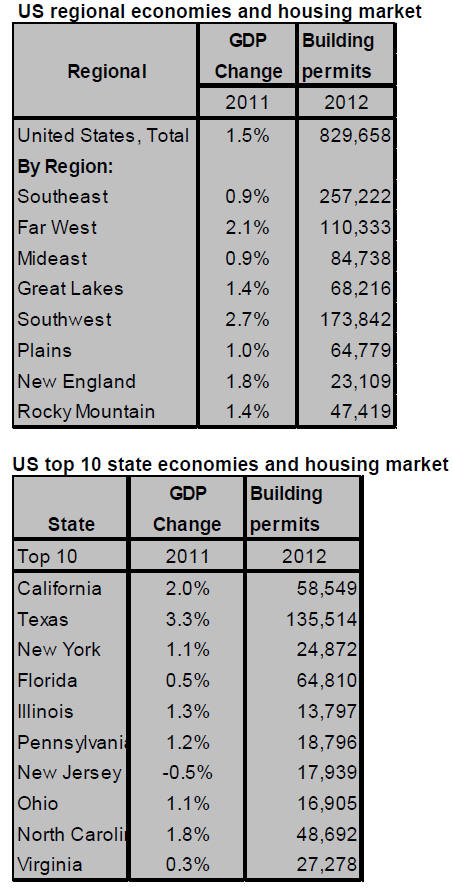|
Report
from
North America
Job creation remains the biggest challenge for US
According to revisions released by the Commerce Department the U.S.
economy grew at a slightly slower pace than originally reported in the
first quarter.
The revisions show that GDP rose at a 2.4% annual rate in the first
three months of the year, down slightly from the 2.5% originally
reported.
The Commerce Department tends to revise GDP figures as new data becomes
available after the initial release. Despite the downward revision this
did not change the overall picture of the economy. Recent data indicates
that consumer spending expanded in the first quarter but job creation to
lower unemployment remains the biggest challenge.

New legislation to encourage residential construction loans
The Home Building Lending Improvement Act of 2013 has been introduced in
the US Senate to encourage lending to home builders. New home
construction lags the demand for housing, and home builders lay the
blame partly on difficult access to loans for construction.
A similar bill, the Home Construction Lending Regulatory Improvement Act
of 2013, was introduced in the US House of Representatives in March
2013.
The National Association of Home Builders expects from the proposed
legislation not only more construction of new homes, but positive
effects on local economies, job growth and increased government revenue.
Tropical sawn hardwood imports trail temperate species imports
Total US hardwood sawnwood imports soared in March, but the increase
was entirely of temperate hardwood imports. Temperate sawn hardwood
imports increased by 131% from February, to 78,403 cu.m., while tropical
sawn hardwood grew by 20% to 14,656 cu.m.
The majority of the additional temperate hardwood volume comes from
Uruguay, South Africa and Canada. Year-to-date imports of tropical
sawnwood are 10% lower than in March 2012.
Imports from Brazil rose to 3,485 cu.m. in March (+38% year-to-date).
The increase was mainly in shipments of ipe (1,811 cu.m.) and virola
(911 cu.m.).
Balsa imports from Ecuador increased to 2,673 cu.m. from February, but
they remained below 2012 levels (-36% year-to-date).
March imports from Peru were small at 259 cu.m., but year-to-date
imports are still 18% higher than in 2012 because of the large volume of
virola imported in January.Imports from Malaysia increased to 1,453 cu.m.
(+1% year-to-date), despite a decline in keruing shipments to 910 cu.m.
Cameroon¡¯s shipments to the US declined to 973 cu.m. in March (-30%
year-to-date). Sapeli shipments fell to 637 cu.m.

US regional and state economies and housing markets
The Southeast of the US is the largest economic region, followed by
the Far West and the Mid-eastern states. GDP grew in all states and
regions in 2011 (latest data available), but the rate of growth slowed
from the previous year.
The only region where growth accelerated from 2010 was the Far West,
which includes the states of Alaska, California, Hawaii, Nevada, Oregon
and Washington.
The overall fastest growing region in the US was the Southwest. The
growth was led by Texas with a 3.3% increase in real GDP.
California is the largest state in the US, both in GDP and population,
accounting for 13% of the total US economy. Californians also have a
higher than average personal income, only surpassed by states in New
England and in the Mid-eastern states.
The housing market crash in 2008 and 2009 affected the regions
differently. Among the hardest hit were Arizona, California and Florida.
Cities here also show the largest increases in home sales, now that the
housing market is recovering. Texas remained the largest market in the
US in terms of building permits issued in 2012, despite California¡¯s
larger population.
¡¡

¡¡
|